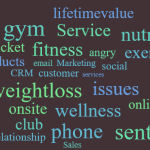Wanted to share “lessons learned” from the Diabetes & Exercise Alliance (D&E) on networking strategies for increasing visibility and membership.
D&E operates on a shoestring, so their marketing plan emphasizes collaboration with non-profits and local businesses.
How well did the plan work?
At the end of the day, D&E was one of the largest fundraisers in the U.S. for one of its largest non-profit networking partners – and grew their own in-house email list eight times over.
Their local outreach attracted attention from other regions who are now initiating their own local chapters.
And D&E members have been publicly recognized as leaders in the diabetic community, receiving high-visibility speaking opportunities. All of which, of course, serves their original objective: to grow membership of their organization.
Their experience offers valuable lessons for every health and wellness business trying to grow through networking and collaboration with local non-profits and like-minded businesses.
1) Relationships first, results second
Many wellness businesses make a superficial networking contact, then quickly move into sales mode, looking right away for answers to “What’s in it for me?”
Big mistake. Focus first on demonstrating that YOU can bring value to the networking relationship.
For example, D&E supported American Diabetes Association’s Tour de Cure endurance cycling fundraiser by hosting and promoting training rides. They demonstrated that they were a trustworthy partner with an ability to increase Tour de Cure fundraising.
In exchange, ADA gave them visibility to a much larger group of people with diabetes who share an interest in exercise and fitness, many of whom joined D&E’s mailing list. They’ve also allowed them to hold meetings at their offices and been useful in many, many other ways.
2) Be creative
A triathlon training business volunteered to open their storefront early so that D&E’s training rides could start from their extremely convenient location. They volunteered free cold water, too.
The D&E guys were thrilled. Most businesses would be too inflexible – “Too much trouble to open up early.” Or they wouldn’t bother because they might not instantly get new clients. Or they’d use that old standby focused on THEIR needs: “We’ll give anyone in your group who signs up for one of our programs a free week when they buy a 3- or 6-month training package.”
On the other hand, cold water and a handy start location actually met D&E’s most critical needs at that particular moment.
Alas…this part of the story doesn’t end well. More on that in a moment.
3) Do meaningful stuff
The D&E group promoted their own activities and ADA’s fundraising events via email. They posted actively on ADA’s Tour de Cure Facebook page where the two organizations shared common interest. They exchanged confidence-building messages with potential participants. They posted photos and videos after every training ride along with funny stories. They took the time to tag folks in photos.
They physically picked up the phone and live-called the list of people who had expressed an interest in joining the ADA’s Tour de Cure ride. (Yes, they called strangers and talked to them.)
Result? Lots more people signed up to ride for a cure. And many of them joined D&E.
4) Know your audience
D&E knows its audience and explicitly addresses their interests. The group’s focus is on helping people with diabetes who exercise find the best ways to balance activity, food, and insulin or other meds. It’s not about losing weight, or eating right. It’s not about preventing diabetes or tackling childhood obesity.
So they know, for example, that people with diabetes worry about going low when they exercise. They feel unpleasantly conspicuous if they’re the only person on a ride who stops to test blood sugar.
Therefore, on D&E’s rides, they always have gels, in case someone’s blood sugar goes low. They stop as a group to test blood sugar at various points. They have a check-in process so that if someone leaves the ride early, they know that person got back to the parking lot OK. They actively trade tips in face-to-face meetings and via social media and email newsletters on what does and doesn’t work to manage blood sugar, exercise, food and medication.
The result: whenever someone with diabetes finds out about D&E, the usual reaction is “Thank goodness, I didn’t think anything like this existed!”
Can you imagine a better reaction from your potential clients, customers or members?
5) Keep your promises
Remember the triathlon training business?
Bad news: they didn’t deliver on any of their commitments. D&E had to scramble to find a new location and make arrangements for water.
Big mistake, because many members of D&E’s organization are extremely fit and quite a few are training for triathlons. Will they choose these folks when they’re ready for, say, triathlon swim training. Not a chance.
On the other hand, ADA’s been frustrated in prior years by groups that promised to hold training rides, then canceled them if only a few people showed up. D&E committed to hold every ride it scheduled, even if just one person showed. And you know what? Participation built, and built – nearly every ride had dozens of participants!
The lesson: overnight success rarely happens. Consistency builds momentum. Don’t give up just because initial participation is low.
6) Give to get
One merchandise vendor is constantly trying to promote its product to D&E’s membership. But all they ever do is post “buy now” links. What if they offered free product to members in exchange for wearing logo’d shirts in events? What if they offered to sponsor the email newsletter in exchange for an ad in every issue?
7) Over and over and over
If you’re building your business through involvement in a non-profit,your wellness business needs to stay visible and connect to people throughout the year.
Many non-profits focus on just one big public fundraiser per year. That’s fine for them – but your business shouldn’t let its efforts go dormant for months as a result.Think about what you can do during to continue outreach.
For the D&E folks, that meant multiple training rides, multiple email updates, multiple Facebook posts, multiple phone calls and so on. Once running season started, they switched their focus to different networking relationships that targeted runners and walkers instead of cyclists.
8) Drop duds
Lots of networking contacts never go anywhere. Don’t waste your time on them; just move on if the relationship’s not developing. No harm, no foul.
D&E reached out to one large diabetes organization that wasn’t very responsive. When nothing really clicked after a few months, D&E refocused its efforts elsewhere.
9) How to choose
- Target organizations with a logical connection to your wellness business’s target audience. If you want to focus on super-fit people, don’t invest your efforts in the Arthritis Foundation
- Avoid heavily organized groups like the Leukemia and Lymphoma Society’s (Team-in-Training) Susan B. Komen. Your local wellness business will usually be lost in all the hubbub.
- Look for active organizations with ongoing scheduled public activities and events, engaged volunteer AND paid leadership and staff. Those touch points can lead to new clients for your business.
- Tiny unfunded organizations staffed only by a parttime unpaid director usually won’t offer the kinds of engagement opportunities that can ultimately benefit your wellness business.
- Monitor the quality of the relationship. Do they do what they say they will, even on the smallest matters? Are they open to doing things that benefit you, not just them? The name of the game is “I scratch your back, you scratch mine.”




